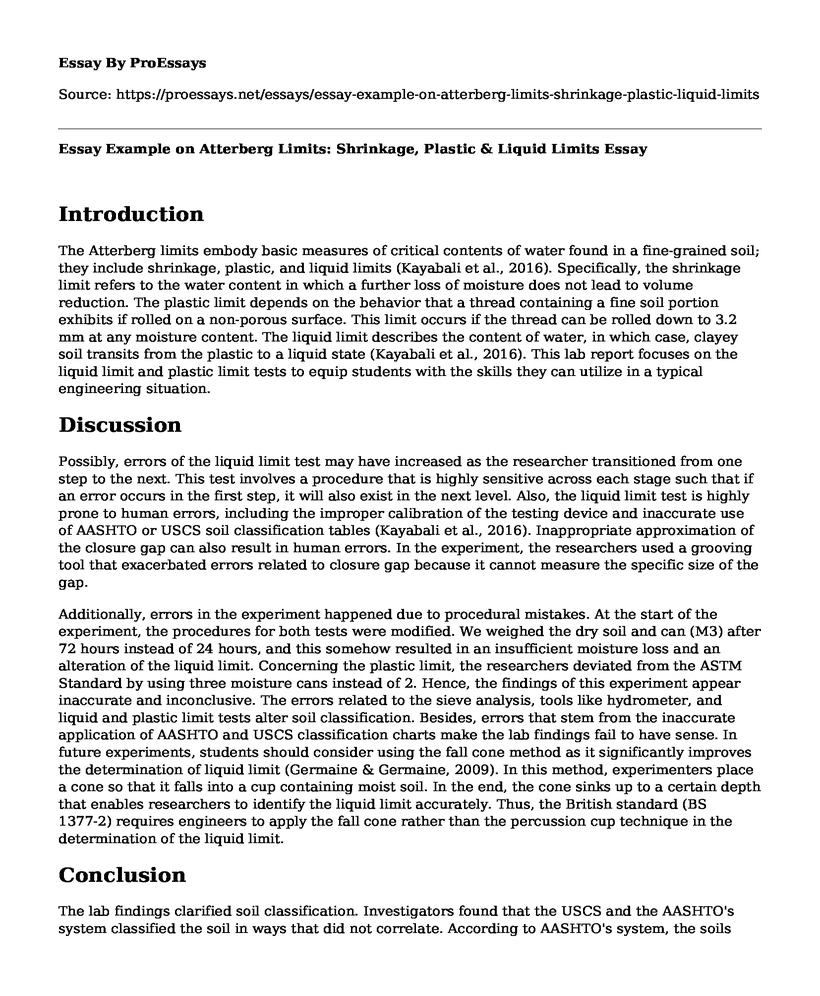Introduction
The Atterberg limits embody basic measures of critical contents of water found in a fine-grained soil; they include shrinkage, plastic, and liquid limits (Kayabali et al., 2016). Specifically, the shrinkage limit refers to the water content in which a further loss of moisture does not lead to volume reduction. The plastic limit depends on the behavior that a thread containing a fine soil portion exhibits if rolled on a non-porous surface. This limit occurs if the thread can be rolled down to 3.2 mm at any moisture content. The liquid limit describes the content of water, in which case, clayey soil transits from the plastic to a liquid state (Kayabali et al., 2016). This lab report focuses on the liquid limit and plastic limit tests to equip students with the skills they can utilize in a typical engineering situation.
Discussion
Possibly, errors of the liquid limit test may have increased as the researcher transitioned from one step to the next. This test involves a procedure that is highly sensitive across each stage such that if an error occurs in the first step, it will also exist in the next level. Also, the liquid limit test is highly prone to human errors, including the improper calibration of the testing device and inaccurate use of AASHTO or USCS soil classification tables (Kayabali et al., 2016). Inappropriate approximation of the closure gap can also result in human errors. In the experiment, the researchers used a grooving tool that exacerbated errors related to closure gap because it cannot measure the specific size of the gap.
Additionally, errors in the experiment happened due to procedural mistakes. At the start of the experiment, the procedures for both tests were modified. We weighed the dry soil and can (M3) after 72 hours instead of 24 hours, and this somehow resulted in an insufficient moisture loss and an alteration of the liquid limit. Concerning the plastic limit, the researchers deviated from the ASTM Standard by using three moisture cans instead of 2. Hence, the findings of this experiment appear inaccurate and inconclusive. The errors related to the sieve analysis, tools like hydrometer, and liquid and plastic limit tests alter soil classification. Besides, errors that stem from the inaccurate application of AASHTO and USCS classification charts make the lab findings fail to have sense. In future experiments, students should consider using the fall cone method as it significantly improves the determination of liquid limit (Germaine & Germaine, 2009). In this method, experimenters place a cone so that it falls into a cup containing moist soil. In the end, the cone sinks up to a certain depth that enables researchers to identify the liquid limit accurately. Thus, the British standard (BS 1377-2) requires engineers to apply the fall cone rather than the percussion cup technique in the determination of the liquid limit.
Conclusion
The lab findings clarified soil classification. Investigators found that the USCS and the AASHTO's system classified the soil in ways that did not correlate. According to AASHTO's system, the soils sub-grading ranged from excellent to good. On the other hand, the USCS rated the soil as poorly graded. Liquid and plastic test indexes facilitated the accurate classification of the soil. Hence, professional engineers should be able to determine liquid limit and plastic limit because these tests enable them to classify soil samples precisely. Such knowledge is vital in determining the stability of the foundation and the safety offered by the entire infrastructure.
References
Germaine, J. T., & Germaine, A. V. (2009). Geotechnical laboratory measurements for engineers. Hoboken, N.J: John Wiley.
Kayabali, K., Akturk, O., Fener, M., Ozkeser, A., Ustun, A. B., Dikmen, O., ... & Asadi, R. (2016). Determination of Atterberg limits using newly devised mud press machine.Journal of African Earth Sciences, 116, 127-133. http://dx.doi.org/10.1016/j.jafrearsci.2016.01.005
Cite this page
Essay Example on Atterberg Limits: Shrinkage, Plastic & Liquid Limits. (2023, Feb 23). Retrieved from https://proessays.net/essays/essay-example-on-atterberg-limits-shrinkage-plastic-liquid-limits
If you are the original author of this essay and no longer wish to have it published on the ProEssays website, please click below to request its removal:
- Environmental Consulting Companies - Assignment Example
- International Business and Walmart Paper Example
- Supply Chain Manager's Primary Duties Paper Example
- Essay Sample on Management of Health and Safety at Work
- Essay Example on the Rise of Amazon: From Online Bookshop to World's Largest Retailer
- Essay Example on Debate: Is Studying Law a Guarantee for Success?
- Free Essay on Offshore Drilling: Balancing Economic Demands with Environmental Consequences







